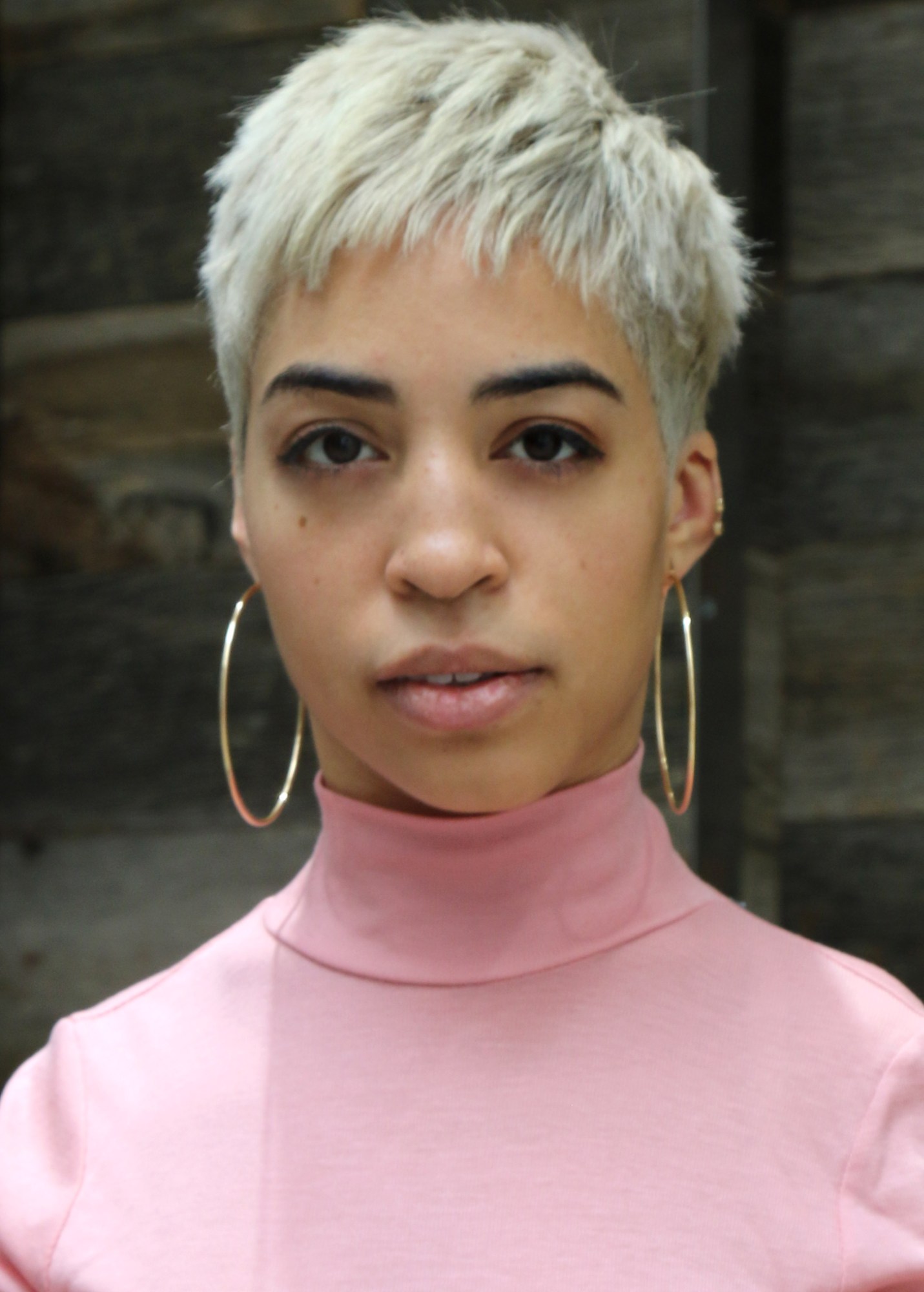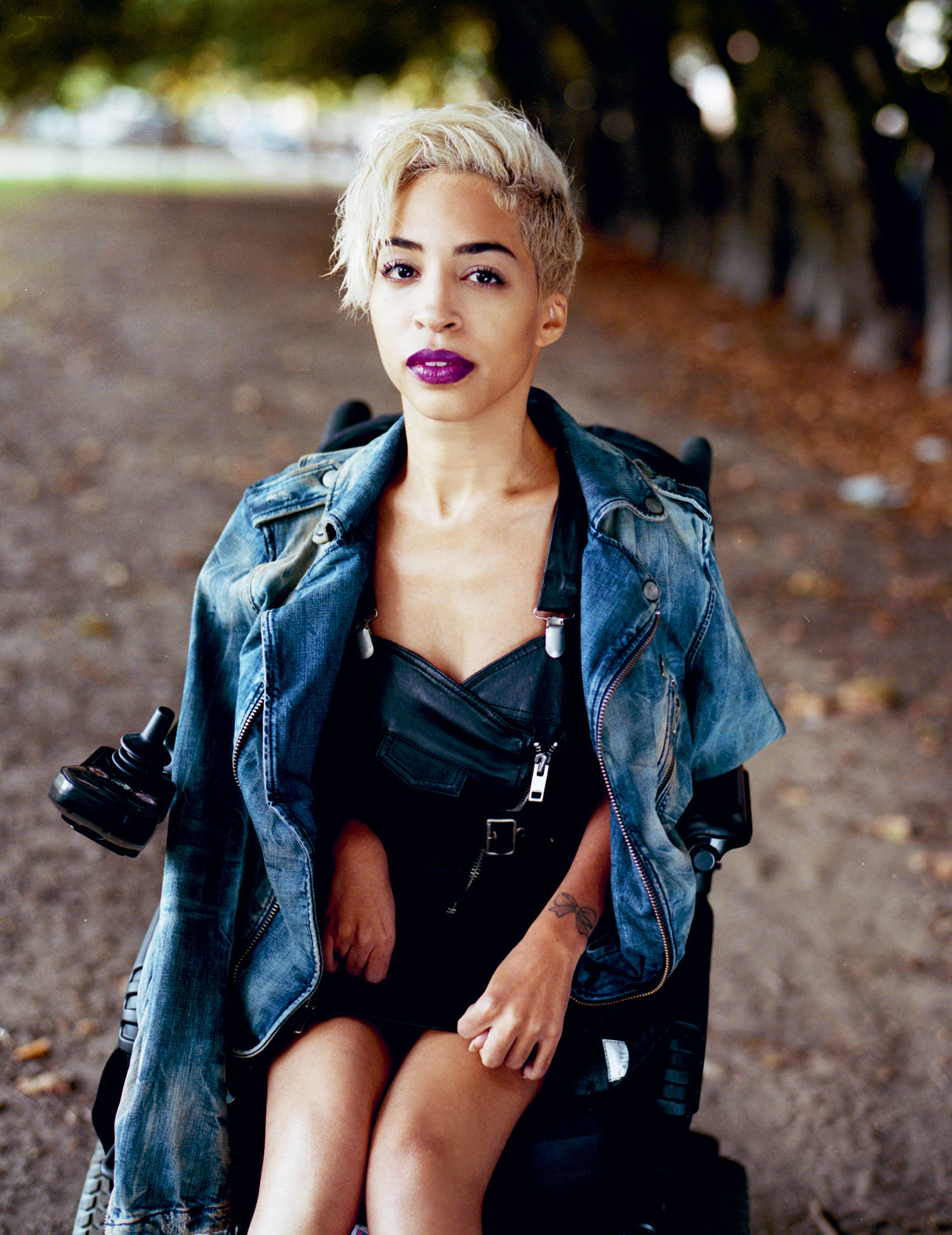Jillian Mercado made a name for herself behind the camera. While working as a fashion editor, Jillian’s flawless makeup game and finger-waved peroxide pixie were constant fixtures on the downtown New York fashion scene, even catching the eye of the legendary Bill Cunningham. But it was after Nicola Formichetti cast her in Diesel campaign that Jillian’s image went global. IMG took note — Jillian is now on the agency’s women’s board, sandwiched between Jessica Stam and Joan Smalls — and then Beyoncé did. Queen Bey cast the freshly minted model in a campaign for merch featuring slogans like “Fresher Than You” “Slay,” and “I Twirl On Them Haters,” all fitting mottos for a woman who hasn’t let a wheelchair confine her ability to smash boundaries and shake up norms.
It’s only recently that professional modeling has begun to truly embrace women of different sizes and skin colors, so for a 5’2” Latinx girl with muscular dystrophy, Jillian is still ahead of her time. But far from being content advocating change in inclusive fashion capitals like New York City, she’s taking her mission global. Last year Jillian traveled to Poland to direct a workshop on beauty and disability for marginalized women in Warsaw. She doesn’t speak Polish — but it turns out red lipstick is great tool for breaking language barriers. “It was about trying to un-brainwash them,” Jillian says, observing that in some countries, disabled people are still shunned from society, hesitant to go out in public let alone roll down the street in wild fashion and fuchsia eyeshadow. “You are worthy, you are beautiful, you are allowed to live your full potential of life. If you want to go off-grid with red lipstick, well goddamn, you should!”
i-D asked Jillian how she uses beauty as self-care, self-confidence, and a way to navigate her Latinx identity.

So we’re talking on the phone — what beauty look are you working with today?
It’s really hot today! I tend to wear less makeup in the summertime, and more moisturizing products, so I have a lot of that on my face. I’m wearing Benefit eyebrow pencil, mascara, and a matte fuschia lipstick. I try to keep it [to] a very bold lip and bold eyebrows. My eyelashes are already pretty long so I put mascara on to make them extra long.
How has your approach to hair and makeup changed over the last few years?
My hair has changed so many times. Until about two years ago I had been every color of the spectrum. I love playing with colors — especially when you’re platinum blonde you can really play with colors. For two years now I have been a brunette, I have been a light brown, I have been a platinum blonde almost to the point of white. But at the moment I’m keeping it my natural color, which is a dark brunette, and I have a pixie cut.
You recently started wearing your hair in its natural, curly state. How has your hair journey been informed by your Latinx identity?
I grew up with very traditionally Dominican parents. They brought their values from the Dominican Republic here [to the United States]. There are a million beautiful and great things about our culture, but for some reason, there’s a stigma that having coarse or curly hair is a bad thing. The first thing you think of when you think of somebody who’s beautiful — not to say that people who have straight hair thing this way — but I personally remember hearing people, when I had my hair curly, say my hair looked crazy, or say something negative about it. When I had my hair straight, I heard it looked beautiful and silky and smooth. I noticed that at a young age. It took me a while to understand that I should embrace my hair. I have a lot of hair! People pay tons of money at salons to even get their hair remotely close to mine. So it’s beautiful to say that it grows out of my head [laughs]. I love my curly hair. I’m wearing it curly now in a pixie, which is something you don’t see a lot, but I kinda dig it.
Was it weird to go from being a local New York fashion editor to a globally recognized model and activist?
I’ve lived so many lives at this point [laughs]. Having the experience of being behind the camera definitely gave me a different outlook on how [fashion and beauty images] are created. Knowing the perspective of being on the outside, being in front of the camera can put that experience into function. It’s more of a collaboration than a job. I’m super thankful that I had the opportunity to be behind the camera and know the ins and outs of it, which gives me a little bit of an advantage when I’m on these jobs, where communication is key to everything.
Is beauty a form of self-care?
Absolutely. Beauty comes in all different forms and is different for each individual person. For me, as far as makeup goes, it’s more like I’m a canvas. I like to splash colors and make a beautiful artwork on my face. I love playing with colors and different trends and making them my own. I love people who have a lot of freckles. I have a few freckles on my face and I accentuate them to make them more visible, or even add a few.
What’s your earliest beauty memory?
How I learned about makeup was through my mom. I used to take my mom’s makeup and play with it, and I’d get in trouble so many times. I definitely remember my earliest memories of watching my mom apply makeup, and dressing in the morning to go to work or to go to church, and thinking she was the most beautiful person I’d ever seen. I remember her applying this very deep brown or maroon lipstick from Revlon. That’s when my infatuation with makeup started.
Who else inspires your looks?
The beautiful thing about New York is that there are so many people from all walks of life. It’s such a diverse place to live that I can see a person on the subway and think, “wow.” I get a lot of my inspiration from people-watching.
How does traveling inform your relationship to beauty?
I went to Poland a few years ago to talk to women there about beauty and about how something so simple, like applying lipstick, can alter how you feel about yourself. I spent 11 days in Poland with these people, giving them little makeovers, and I remember this one lady — she was around 40 — she got really emotional. She said, “In Poland, having a disability is a very, very bad thing.” It’s not talked about and rarely do you see anybody on the street with a disability who’s remotely fashionable or has makeup on. It was a culture shock. How is that a thing or even possible? [Beauty] helps me in terms of confidence. I love shopping and trying different products out. The first glance you have in the mirror in the morning sets you up for the whole day. If you look beautiful you feel beautiful, and as soon as you get out the door your whole day will be better.
Having the workshop with this woman and her hearing me talk about how I lived life — it inspired her to fight the system back. And it was just red lipstick. For me it wasn’t anything dramatic, but for her it was a huge step that she never thought possible. Everyone deserves to feel beautiful! It’s such an incredible, positive feeling, and no one should tell you not to feel that was because they’re uncomfortable with it. I think a lot of that discomfort comes from fear. We’re all beautiful in our own way, and no one should judge anybody else for being different or for being unique. If it betters ourselves, then why not?
